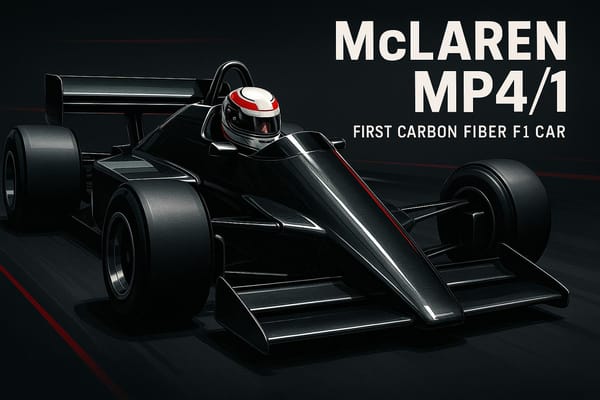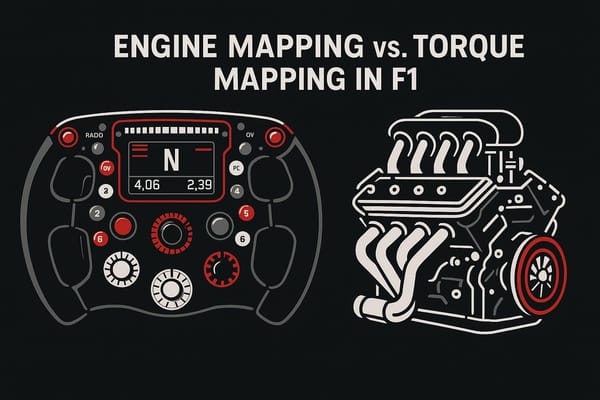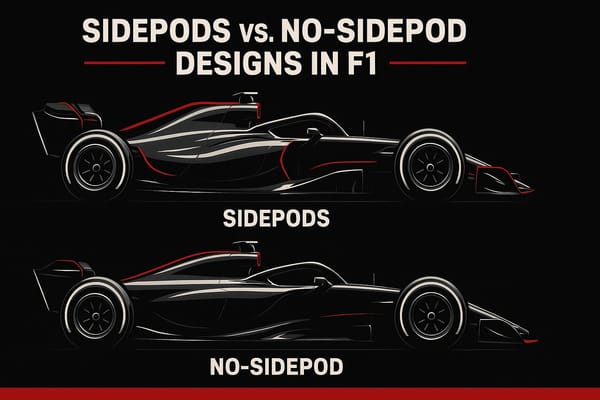Top 10 F1 Pit Stop Strategies That Changed Race Outcomes
Explore pivotal F1 pit stop strategies that reshaped races, highlighting the impact of timing, tire choices, and teamwork on outcomes.
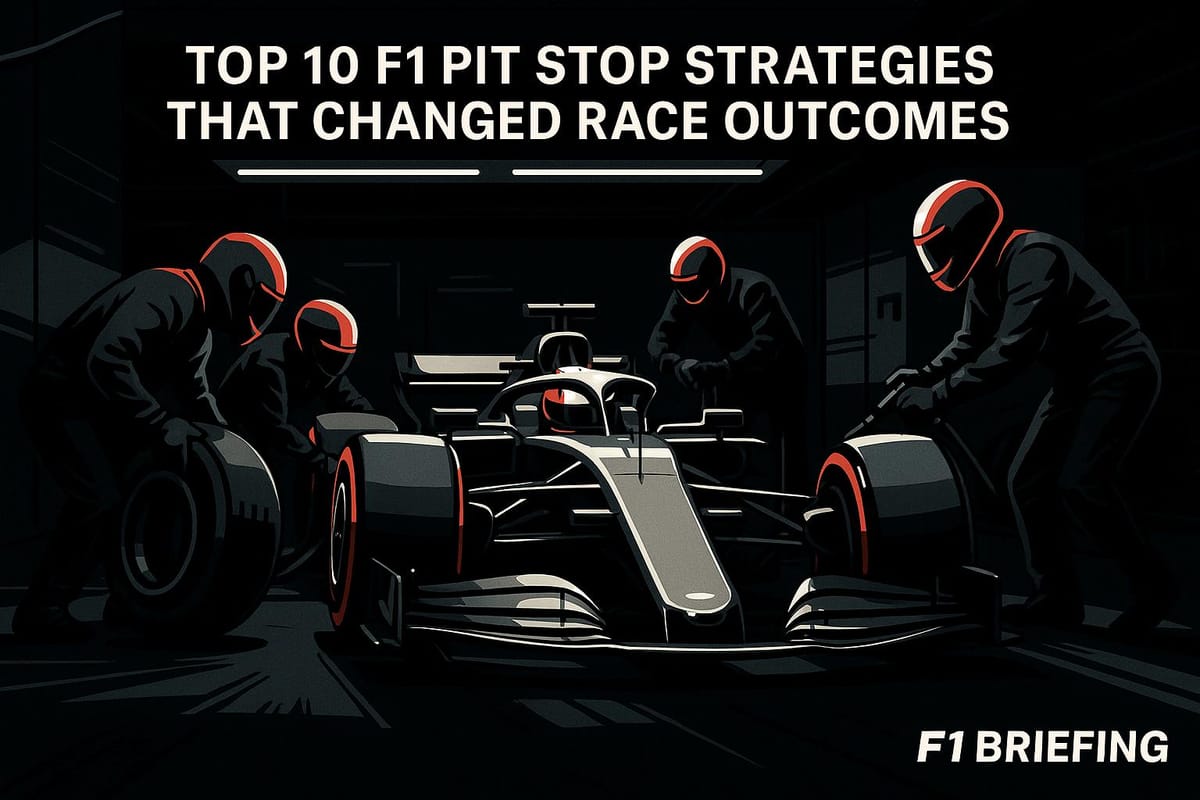
Formula 1 pit stops are more than just quick tire changes - they can determine the winner of a race. Over the years, teams have turned pit stops into a science, combining data, timing, and teamwork to gain an edge. Here’s what you need to know about the most game-changing pit stop strategies:
- Red Bull's 1.92-second stop (2013): The fastest pit stop ever, proving that milliseconds matter.
- Ferrari's tire gamble (2008): A risky wet tire decision that backfired, costing Kimi Räikkönen key positions.
- Mercedes' double pit stop (2020): Perfect timing for a 1-2 finish at the Styrian GP.
- Brawn GP's fuel strategy (2009): A mid-race switch that secured Jenson Button’s win.
- McLaren's record stop (2012): A 2.31-second pit stop that showcased precision under pressure.
- Renault's 'Crashgate' (2008): A controversial safety car strategy that altered race outcomes.
- Haas' pit stop errors (2018): Mistakes that cost the team a potential 22 points.
- Aston Martin's early stop (2023): Tire management and timing kept them competitive.
- Alfa Romeo's data-driven stop (2022): Real-time analytics extended tire stints for better positioning.
Key Takeaways:
- Timing is everything: A well-timed stop can create opportunities or avoid disasters.
- Tire strategy matters: Choosing the right compound can make or break a race.
- Team precision: Flawless execution is critical, as even minor errors can have major consequences.
These moments highlight how F1 teams use strategy, data, and teamwork to turn pit stops into race-winning opportunities. Whether it’s a lightning-fast stop or a bold gamble, pit stops remain one of the most thrilling aspects of Formula 1.
Breaking Down Pit Stop Strategies How Teams Plan
1. Red Bull's Monaco 2021 Undercut Victory
The 2021 Monaco Grand Prix showcased Red Bull Racing's sharp approach to pit stop timing and tire strategy on one of Formula 1's toughest circuits. With overtaking nearly impossible on Monaco's narrow streets, their undercut tactic played a key role in clinching the win.
Monaco's layout demands careful tire management. Pre-race models indicated that soft tires, which perform best for about 40 laps in the 78-lap race, would need changing between laps 20 and 26.
To pull off the undercut, Max Verstappen controlled his pace, extending tire life while staying out of the range where competitors could execute their own undercuts. At the same time, Mercedes faced setbacks, including severe tire wear for Valtteri Bottas, which gave Red Bull an opening to capitalize on their strategy.
Sergio Perez demonstrated the effectiveness of fresh tires, slashing his lap time from 1:32.141 to 1:25.215 - an immediate boost in performance.
This strategic triumph relied on three critical elements: spot-on pit wall timing, managing tire temperatures on Monaco's low-energy track, and securing the best track position. These factors helped Red Bull overcome pit stop challenges and lock in an important victory. It’s a clear example of how split-second decisions in the pits can completely alter the outcome of a race.
2. Ferrari's Wet Tire Call at British GP 2008
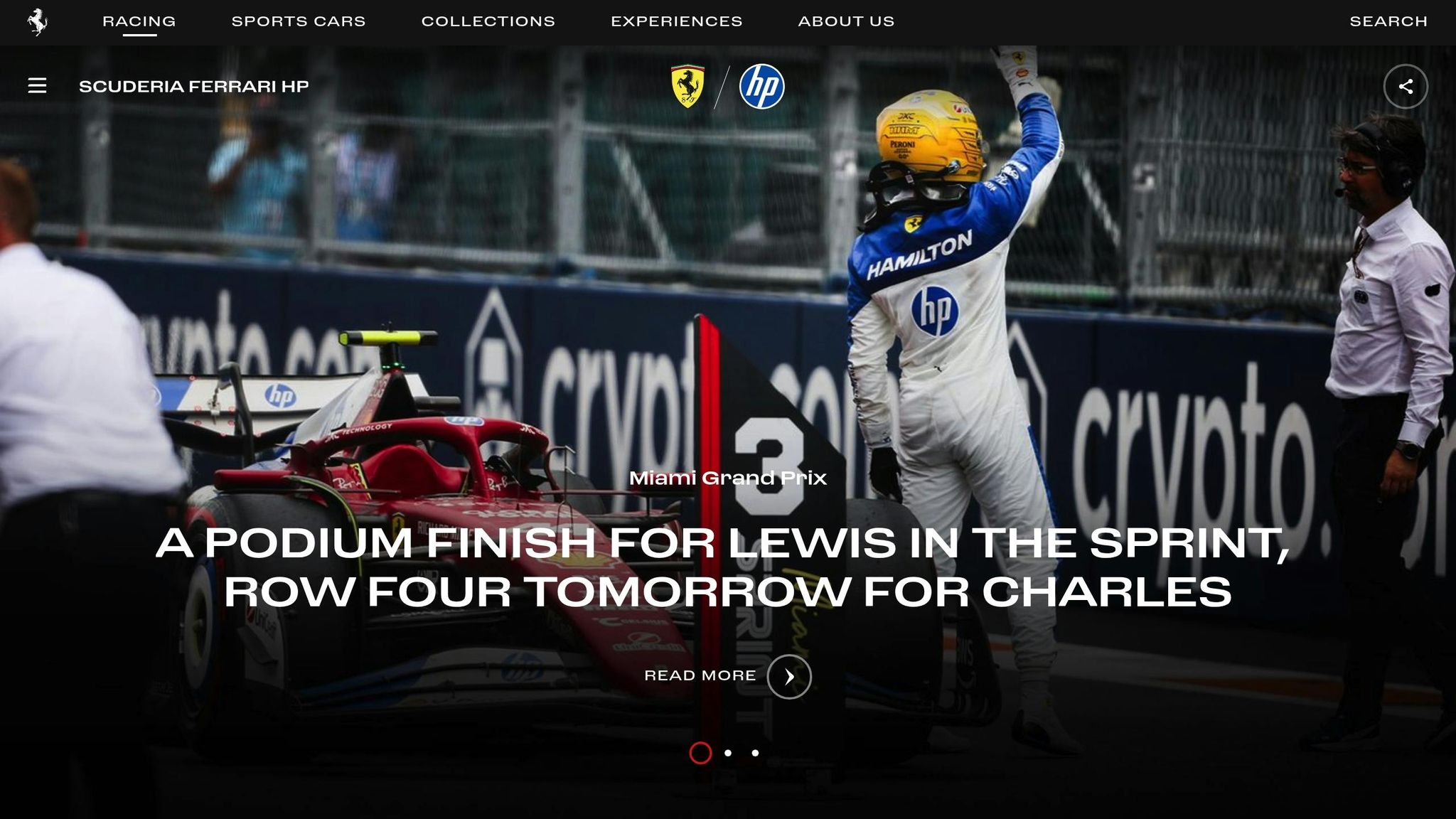
Ferrari's 2008 British Grand Prix strategy is a classic example of how critical timing and weather judgment can make - or break - a race. The event started on a damp track, with all drivers using intermediate wet tires. Teams had to adapt quickly as the track conditions shifted.
As the track began to dry, Kimi Räikkönen was setting impressive lap times, prompting Ferrari to make a bold tire decision. On lap 21, both Räikkönen and Lewis Hamilton pitted at the same time. McLaren chose to equip Hamilton with fresh intermediate tires, but Ferrari gambled by only refueling Räikkönen’s car, leaving him on his worn intermediates, banking on continued drying conditions.
Then the rain returned, and Ferrari's gamble backfired. The impact was immediate and costly:
- Räikkönen lost around 8 seconds per lap compared to Hamilton.
- By lap 27, Heikki Kovalainen and Nick Heidfeld had caught up to him.
- A mandatory pit stop on lap 30 pushed Räikkönen down to 11th place.
"McLaren called the changing conditions perfectly while Ferrari got their strategy badly wrong for Kimi Raikkonen, leaving him to battle his way up to fourth." - RaceFans
This race showcased the stark difference in how McLaren and Ferrari handled the unpredictable British weather. McLaren’s well-timed decision helped Hamilton secure a dominant win, finishing over a minute ahead of the competition. Meanwhile, Ferrari's misstep left Räikkönen struggling to recover throughout the race.
It’s a clear reminder of just how crucial split-second pit stop decisions are, especially in the notoriously unpredictable conditions at Silverstone.
3. Mercedes' Double Pit Stop at Styria 2020
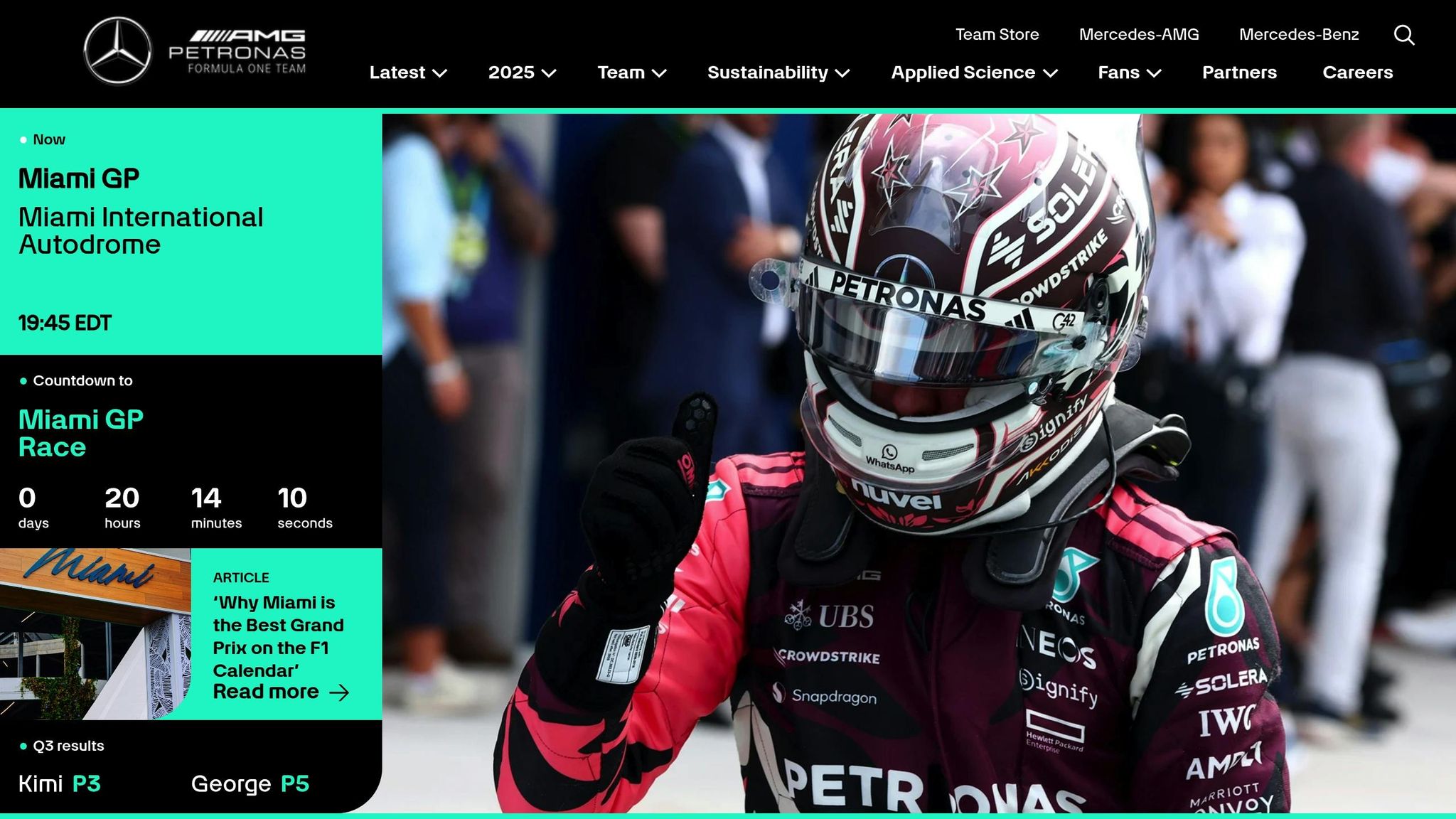
At the 2020 Styrian GP, Mercedes pulled off a double pit stop strategy that secured a dominant 1-2 finish.
The team used a staggered approach, with Hamilton stopping seven laps before Bottas. This timing allowed them to adjust to changing race conditions while ensuring smooth service for both drivers.
While the fastest pit stop on record stands at 1.92 seconds, Mercedes prioritized precision over speed. This carefully executed maneuver highlights how detailed planning in pit stops can make a huge difference in race results.
4. Brawn GP's Fuel Plan at Spain 2009
At the 2009 Spanish Grand Prix, Brawn GP executed a strategy shift that turned a planned three-stop race into a 1-2 finish for the team.
Both Jenson Button and Rubens Barrichello initially started on a three-stop strategy. However, Button was switched to a two-stop plan mid-race when it became evident he might get stuck behind Nico Rosberg's Williams, which had an 18.646-second gap at the time.
"Three stops was always going to be the quickest strategy, particularly with [the hard tires] being so slow", said Ross Brawn.
The change in strategy became evident when Barrichello was informed over the radio that Button had moved "to plan A" after his first pit stop. While Button shifted strategies, Barrichello remained on the original three-stop plan. He later acknowledged that the team initially intended for both cars to follow the same approach. Unfortunately for Barrichello, his third stint was slower than expected, allowing Button - who had a better pace on the harder compound tires - to take the lead.
Button finished the race 13 seconds ahead of Barrichello, extending his championship lead by 12 points. However, this decision stirred debate among fans.
A post-race poll revealed that 53% of respondents believed Brawn GP intentionally gave Barrichello a less effective strategy. This moment continues to stand out as a prime example of how race strategies can shape outcomes - and spark controversy.
5. McLaren's Lightning-Fast Pit Stop at Germany 2012
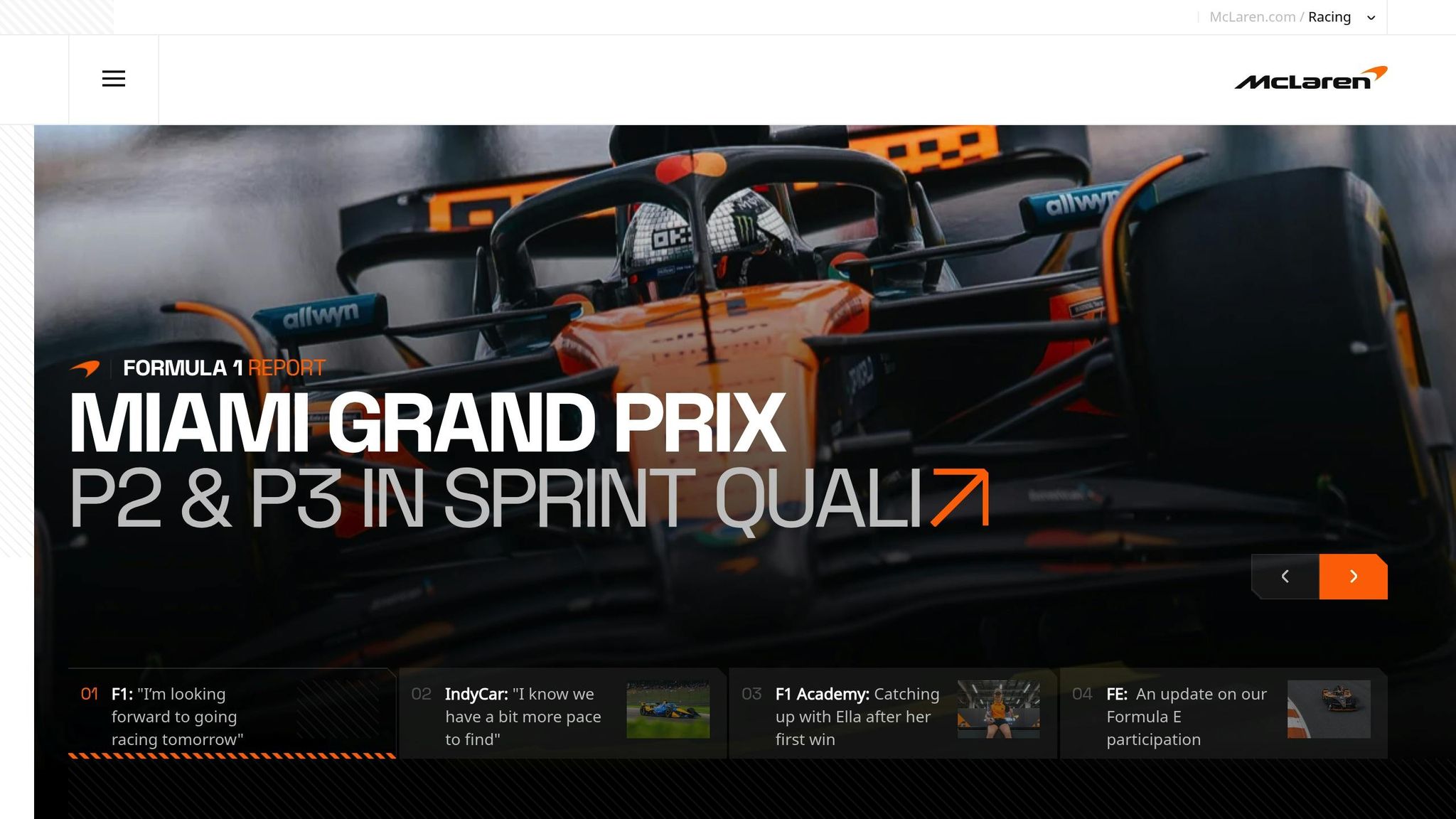
During the 2012 German Grand Prix, McLaren set a stunning pit stop record with Jenson Button. The team swapped out his wheels in just 2.31 seconds, completing the entire pit stop in under 17 seconds - about a full second quicker than Sebastian Vettel's stop. This incredible display of precision highlights how tiny margins can make a huge difference in securing track position, showcasing the ever-evolving tactics that influence race results.
6. Williams' Tire Choice at Europe 1997

The Williams team understood how tire wear could impact performance. By closely analyzing how the tires were degrading and factoring in the track conditions, they pinpointed the perfect time to make a pit stop for new tires.
This decision paid off, as the fresh tires provided better grip and improved lap times. The move gave Williams a key advantage in track position, showing just how important it is to time tire changes correctly to stay ahead in a race.
7. Renault's Safety Car Timing at Singapore 2008
Renault's bold strategy during the Singapore Grand Prix in 2008 showcased how unexpected pit stop timing can completely alter the course of a race. Fernando Alonso made an early pit stop on lap 12, which seemed unusual at the time. Just three laps later, his teammate Nelson Piquet Jr. crashed, bringing out the safety car. This timing worked in Alonso's favor, as other drivers had to pit during the safety car period, losing their track positions.
"Obviously we started at the back and the first safety car helped me a lot and I was able to win the race." – Fernando Alonso
This early pit stop triggered a chain of events that reshaped the race. Under the safety car rules at the time, cars were required to pit in sequence, which nullified any advantage others had gained. What initially appeared to be a clever move soon unraveled into controversy.
The incident, later dubbed 'Crashgate,' revealed that Piquet's crash had been orchestrated to benefit Alonso. This led to severe consequences for Renault, including the departure of key figures like Flavio Briatore and Pat Symonds, as well as significant penalties.
"There is something fundamentally rotten and wrong at the heart of Formula One. Never in my experience has Formula One been in such a mood of self-destruction. Millions of fans are amazed, if not disgusted, at a sport which now goes from crisis to crisis with everyone blaming everyone else." – Sir Jackie Stewart
The scandal prompted changes to safety car regulations, aiming to prevent teams from exploiting pit stop timing in the future. While the strategy secured Alonso a win, it left a lasting stain on Formula One's reputation and led to reforms in race management practices.
8. Haas' Pit Stop Errors at Australia 2018
The 2018 Australian Grand Prix highlighted how pit stop mistakes can completely derail a team's race. Haas F1 Team faced a major setback when both Kevin Magnussen and Romain Grosjean had to retire due to issues during their pit stops. At the time, they were running in fourth and fifth places. The problem? Cross-threaded wheel nuts caused the wheels to be improperly secured, leading to unsafe releases. This error cost Haas a potential 22 points - nearly half of their total points from the 2017 season.
"Pit stop errors occur in racing, though they should be avoidable."
– Guenther Steiner
The financial hit came quickly, with the FIA fining the team €10,000 for the unsafe releases. Beyond the immediate penalty, those lost points could have pushed Haas to fourth place in the constructors' championship.
To address these costly mistakes, Team Principal Guenther Steiner and the crew made several adjustments:
- Reassigned mechanics to different roles to rebuild confidence
- Added an extra safety checker to oversee green light signals
- Prioritized reliability over speed during pit stops
- Increased the frequency of pit stop practice sessions
"We need to make sure we get the wheels on. Even if it takes half a second longer. I cannot tell you yes or no, but what we need to do is solid stops. We don't need 2.4s stops. We need solid 3-second stops. If you do them in 2.7s, fine. But we're not going to 2.3s, 2.4s."
– Guenther Steiner
The team's dedication to improvement was clear. Driver Kevin Magnussen highlighted their preparation efforts:
"The team has done like 300 pit-stops leading up to this race, whereas last year it was more like 20 or something. While never completely risk-free, we've prepared a lot better this year. That's the first box ticked."
– Kevin Magnussen
Haas's experience at the 2018 Australian Grand Prix serves as a reminder that in Formula 1, pit stop reliability can be just as crucial as speed.
9. Aston Martin's Early Stop at Saudi Arabia 2023
Aston Martin's decision to make an early pit stop during the 2023 Saudi Arabian Grand Prix showcased how tire management and timing play a key role in Formula 1. The team’s focus on managing tire wear and heat was essential to staying competitive throughout the race. This strategy offered insights into how they handled tire temperatures and degradation with precision.
Engineers paid close attention to pre-race tire temperatures, knowing that a 10°C increase in rim temperature could raise the tire’s temperature by about 1°C. They used advanced real-time software to track tire wear, enabling informed decisions about when to pit. Their approach revolved around three main factors:
- Temperature Management: Adjusting brake bias to control tire heat via rim warming.
- Degradation Control: Implementing lift-and-coast techniques to ease stress on the tires.
- Timing Accuracy: Relying on predictive tools to determine the best moment for a tire change.
This strategy required the driver to balance speed with tire preservation, ensuring strong lap times without compromising tire performance.
Aston Martin’s pit crew also played a critical role by combining speed and precision, as shown in their approach:
| Strategy Component | Implementation | Impact |
|---|---|---|
| Tire Preheating | Controlled blanket temperatures | Improved initial grip and performance |
| Track Warm-up | Gradual heat buildup during laps | Prolonged tire durability |
| Brake Bias | Fine-tuned adjustments | Effective rim temperature control |
This combination of driver skill, engineering expertise, and precise execution kept Aston Martin competitive on race day.
10. Alfa Romeo's Late Stop at Italy 2022
At the 2022 Italian Grand Prix, Alfa Romeo showcased how timing and data can shape race outcomes. Their pit stop strategy focused on extending tire stints by relying heavily on real-time analytics. This approach highlights how Formula 1 teams use live data to make critical decisions in the moment.
The strategy revolved around three main components:
| Key Focus | Execution | Outcome |
|---|---|---|
| Tire Wear Monitoring | Tracking wear patterns in real time | Prolonged tire performance |
| Track Position Analysis | Assessing gaps to competitors | Secured crucial track position |
| Weather Monitoring | Adapting to track and temperature changes | Improved performance during variable conditions |
This table breaks down the elements that contributed to their effective strategy. By analyzing data, the team extended their pit window while maintaining competitive lap times.
Clear communication between the driver and pit wall was crucial, allowing swift changes based on track conditions. This teamwork emphasized the role of real-time data and constant updates during the race.
Alfa Romeo's approach highlights the balance between timing, data insights, and quick decision-making that modern F1 teams rely on to stay competitive. Their performance at Monza illustrates how combining flexible strategies with precise data analysis is essential in today's racing landscape.
Pit Stop Strategy Lessons
The strategies mentioned above highlight lessons that continue to influence modern pit stop tactics. Today’s Formula 1 pit stops are a mix of precise timing and data-driven decisions.
Modern teams analyze billions of data points and run millions of simulations each season. This intense focus on data has reduced pit stop times significantly - from 67 seconds in the 1950s to an average of just 2–2.5 seconds today.
| Strategic Element | Key Consideration | Impact on Race Outcome |
|---|---|---|
| Timing Precision | Weather conditions and track position | Immediate position gains or losses |
| Tire Selection | Compound choice based on degradation data | Long-term race pace |
| Fuel Management | Balancing performance and efficiency | Strategic flexibility |
This emphasis on precision is echoed by team leaders:
"It's no-good breaking a world record if the next pit stop is five seconds! We make it clear to the crew that meeting our consistency targets set out at the start of the year will ultimately lead to the best on track performance for the team." – Charlie Hooper, McLaren Operations Director
Key Insights
-
Data-Driven Decisions
Teams now use real-time data to track tire wear, performance changes, and weather conditions. This shift has turned strategy into a science rather than relying on gut instinct. -
Flexible Planning
Pit stop strategies are constantly adjusted during the race to respond to changing conditions.
"Everybody's doing everything in their power to find milliseconds, and that's what makes the difference between winning and losing." – Dan Keyworth, Director of Business Technology at McLaren Racing
Critical Factors for Success
- Timing Precision: Analyzing data streams to find the perfect moment for a pit stop.
- Crew Performance: Prioritizing consistent execution over chasing record-breaking times.
- Communication: Ensuring seamless coordination between strategists, engineers, and drivers.
With advanced analytics, rigorous crew training, and well-thought-out strategies, pit stops have become pivotal moments that can determine the outcome of a race. Teams now rely on these elements to secure their competitive edge.
Conclusion
Formula One pit stop strategies have transformed dramatically, moving from instinct-based decisions to precise, data-driven operations that can decide the outcome of a race. Today, pit stops average just 2–2.5 seconds, showcasing how critical timing and accuracy have become.
This isn't just theory - it's reflected in race results. For example, during the 2024 Italian Grand Prix, Charles Leclerc's one-stop strategy highlighted how even tenths of a second can make a difference . Every fraction of a second in the pits can be the difference between winning and losing.
Modern pit stops are a blend of human skill and advanced technology. Teams now rely on up to 22 crew members and conduct nearly 60 practice stops during a single race weekend. It's a testament to the sport's incredible level of preparation and precision.
Looking forward, advancements in technology and data analytics will continue to shape pit stop strategies. Teams that master the balance of speed, precision, and flawless execution will maintain their edge in this high-stakes aspect of Formula One. Pit stops remain a vital part of the sport's strategy and competition.
FAQs
How do F1 teams make split-second pit stop decisions during a race?
F1 teams rely on real-time data analysis to make critical pit stop decisions that can determine the outcome of a race. Using telemetry data from the cars, teams monitor factors like tire wear, fuel levels, track conditions, and the strategies of rival teams. This data helps them adapt their plans instantly and seize opportunities as they arise.
Advanced simulations and machine learning also play a role, allowing teams to predict race scenarios and refine strategies. By combining this technology with expert judgment, strategists can make split-second calls to optimize pit stop timing, tire choices, and overall race performance.
What factors determine the best timing for a pit stop in Formula 1?
The timing of a pit stop in Formula 1 depends on several key factors that can make or break a race strategy. Teams carefully analyze tire performance, including wear and degradation, to decide the optimal moment for a tire change. Track position and the strategies of rival teams also play a crucial role, as a well-timed stop can help gain or maintain an advantage on the track.
Other important considerations include weather conditions (like rain or changing temperatures), the specific characteristics of the track, and the number of stops planned for the race. Teams must weigh the benefits of fresh tires against the time lost during the stop, aiming to balance speed and efficiency to secure the best possible outcome.
How have Formula 1 pit stop strategies evolved to shape race outcomes over time?
Formula 1 pit stop strategies have undergone significant evolution, transforming from basic roadside repairs in the early 20th century to highly choreographed operations lasting under three seconds today. Early innovations, such as Mercedes' streamlined pit stops in the 1930s, set the foundation for modern precision.
Key milestones include the introduction and eventual ban of in-race refueling, which shifted the focus to tire changes and timing strategies. Teams now rely heavily on data analysis to perfect tactics like the undercut and overcut, using pit stops to gain critical track position. The introduction of the DHL Fastest Pit Stop Award in 2016 further underscores the importance of flawless execution, with teams like Red Bull and Williams consistently setting new benchmarks.
Modern F1 pit stops are a testament to teamwork, technology, and split-second decision-making, proving that even a fraction of a second can change the outcome of a race.

